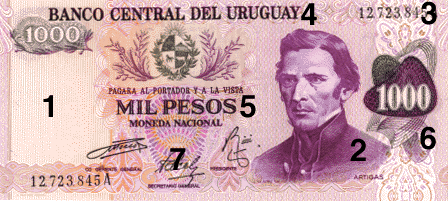Paper Money Features - Anatomy of a Banknote -

1--Watermark
A watermark is put onto a banknote's paper prior to the printing process as a security device which deters counterfeiters.
When held up to the light, a watermark is visible as either a gray image on a white background or vice versa. Whenever you
see a blank spot on a bill, it is usually a watermark.
2--Portrait
Many banknotes have a portrait of a dignitary on them. Often, the watermark is a duplicate of the portrait.
3--Serial Number
The serial number is perhaps one of the oldest security devices on a banknote. Using unique serial numbers on each bill,
governments are able to closely track legitimate bills.
4--Issuing Authority
In this case it is "Banco Central del Uruguay" or The Central Bank of Uruguay. This is the agency responsible for issuing
currency in that country. At certain points in history there may have been many more than one issuing authority within the same country.
5--Denomination
The denomination shows how much of what type of currency the banknote is. In this example it is "Mil Pesos" or 1,000 pesos.
6--Background
The intricate colorful backgrounds on many notes make them more difficult for would be counterfeiters to duplicate.
7--Authorized Signatories
These signatures represent a stamp of approval making the currency official. Long ago, most banknotes were printed but did not
become legal tender until each one was signed individually by the authorized signatories. Usually at least one of the signatures
is the Treasurer of the issuing authority.
Other features not shown on this banknote:

 |
Issue Date
Most banknotes have an issue date on the front which often includes not only the year of issue but also the month and day.
The two samples shown at the left exhibit the day, month and year in their dates. They are from France and Germany (top to bottom).
|
  |
Metallic Thread
Some sophisticated banknotes include a metallic thread woven into the paper of the money itself. Some of the newer U.S.
issues include a metallic strip embossed with the denomination of the bill.
The metallic thread is seen in the sample at the far left as a shadowy vertical line in the bank note from France. But in
the note at the near left from England, the metallic strip is not embedded completely into the paper. At intervals it shows
through as small shiny metal spots that look a bit like aluminum foil.
|

 |
Colorful Threads
A great number of modern banknotes include tiny little colorful threads manufactured into the paper. These are much smaller
than the metallic thread and are usually lightly dispersed throughout the paper. However, sometimes a note will have a dense
band of these colorful threads running through it which creates an interesting effect.
Both of the examples at left are from Germany. The top contains blue threads only and does not contain any threads at all on
the right 1/3 of the note. The bottom example contains both blue and red threads only in the right 1/4 of the note.
|

 |
Printer's Name
Oftentimes the printing company's name will appear on a banknote in very small letters (sometimes abbreviated also)
usually in the white frame area at the bottom of the bill.
|
  |
Overprints
It sometimes becomes neccessary for an issuing authority to 'revalue' a country's money in order to combat extreme inflation.
As a temporary measure while new notes are being printed and distributed, the existing notes are sometimes overprinted or
stamped with a new value.
At the far left is a 10,000 Bolivian Peso note which has been stamped with a new denomination of 1 Bolivian Centavo.
At the near left is a Brazilian 1,000 Cruzado note which has been overprinted with it's adjusted value of 1 New Cruzado.
|
 |
Bar Codes
This new note from the Netherlands includes a bar coded serial number on the reverse side. This facilitates high speed
tracking of individual bills and acts as a deterrent to would be counterfeiters.
|
|
Color Shifting Ink
The 1996 series of U.S. banknotes feature a durable color shifting ink in one set of numbers which changes color from
metallic green to black depending on the angle you view it from. I believe this is the first set of banknotes ($20, $50, $100)
to feature color shifting ink because previous types of ink were not durable enough to be used on banknotes.
|
|
Microprint
All U.S. banknotes feature microprint which is printing so small that it can barely be distinguished with the naked eye. As
such, most people don't ever realize it is there. Upon inspection of a crisp uncirculated note with a magnifying glass, you
will be able to see incredibly small printing designed to foil counterfeiters. There is currently no commonly available machinery
or equipment (including computer scanners/printers or copying machines) capable of reproducing microprinting.
|
|
UltraViolet Ink
Some banknotes have areas printed with UV ink. These areas are usually overprints over an existing patterned area. UV ink
is invisible unless viewed under special UV light bulbs. Many collectors don't know that this exists on banknotes. We'll work
on getting some pictures up soon.
|
|
Holograms
We'll work on getting photos of holograms on paper money and other banknote features posted soon.
|
|